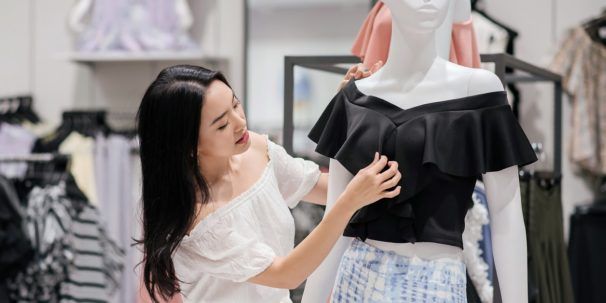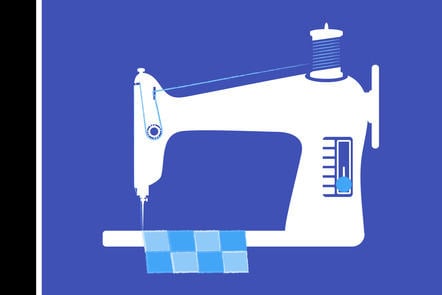The future of fashion: What’s next for fashion technology?
In this article, we explore how fashion technology is making waves in the fashion industry, looking at everything from AI to 3D printing.

In previous blog posts, we’ve discussed exciting fashion careers in the industry and explored sustainable fashion. Today, we’re thinking more about technological innovation within fashion – an industry that has traditionally relied mostly on the work of humans.
Fashion brands and companies are now making use of innovative technologies including blockchain and virtual reality to create a different experience for their customers. In this article, we’ll explore all of these current technologies and ask whether fashion innovation has the power to permanently change the industry for the better.
What is meant by the term fashion technology?
You may be wondering what we mean by the term fashion technology, so we’ll define it for you. Fashion technology is essentially any innovative tech that creates contemporary tools for the industry, whether they improve fashion production or consumption.
It might be used by designers, manufacturers, retailers and customers, depending on the purpose of the particular technology. As more and more technologies become available, we can expect to see fashion tech rise in popularity.
Why is innovation in the fashion industry important?
Innovation is important not only to continually improve the consumer experience, but also to ensure that the fashion industry is moving forward. At the moment, fashion is the second most polluting industry in the world, after oil, and this isn’t sustainable in the slightest.
A lot of fashion technologies help to improve the sustainability of clothing items or the manufacturing process, so in this way, innovation and sustainability are closely linked. If fashion brands aim to be more innovative and sustainable, they can hope to draw in more customers and profit while lessening their social and environmental impact on the planet.
You can learn how ethical and sustainable practice can increase profit for fashion brands in our open step by Creative Skillset. If you’re more interested in the connection between innovation and sustainability, our Fashion Management: Innovation, Entrepreneurship & Sustainability course by Institut Français de la Mode might be interesting to you.
Alternatively, our Innovation: the Fashion Industry course by the University of Leeds will show you how big fashion retailers innovate.




What are the biggest fashion technologies right now?
Now we’re going to discuss the top 9 fashion technologies being used in the industry right now. Over the coming years, we can expect to see even more innovations improving the production and consumption of fashion.
Artificial intelligence (AI)
AI is one of the biggest technologies across all industries right now, not just fashion. Artificial Intelligence is the simulation of human intelligence by computers or machines, and recently, fashion brands have been using it for a variety of purposes.
Applications of AI within fashion include being able to enhance customer experiences, analyse and predict trends, understand buying patterns and even understand fashion aesthetics. One example of this is touchscreens in retail stores that offer customised product advice to customers using AI chat technology. In these scenarios, AI can be trained to understand aesthetics, including colour, texture and style preferences.
Virtual reality (VR)
Another technology that you’ve probably heard plenty about is Virtual Reality, or perhaps Augmented Reality (AR). While VR involves a fully simulated environment, AR adds interactivity and simulations into the real-world environment.
In the fashion industry, VR and AR are incredibly exciting, as they allow for the physical and digital worlds of retail to combine. One of the most popular uses of VR in fashion is technology that allows customers to try on clothes virtually, though it can even go so far as to create a VR version of a whole store.
If you want to learn more about this subject, our Introduction to Virtual, Augmented and Mixed Reality course by Lancaster University and the Institute of Coding will help you discover all the ways in which Extended Reality (XR) is transforming the world.
3D Printing
With the rise of 3D printing in fashion, we can really begin to see how innovation and technology can help brands become more sustainable. 3D printing is a manufacturing process where real products can be created from digital designs.
In our 3D Printing in Textiles open step by Labdox, experts explore the benefits that 3D printing can have on the fashion industry. They explore how 3D printed clothing can lead to significantly less textile wastage than traditional designing, and also explain how 3D printing results in reduced water use, air pollution and water contamination.
Additionally, a designer’s options are unlimited with 3D printing – there are very few constraints when it comes to clothing structure, fabric and creativity. In this way, 3D printing could result in more innovative and exciting fashion designs than ever before.
Novel fabrics and material innovation
An important part of fashion and clothing creation is which materials are used. In the current fast fashion model, synthetic and non-biodegradable fibres are used in approximately 72% of garments, which is a concerning statistic. Novel fabrics, which are brand new materials, could be the answer to this problem.
Not only are novel fabrics an exciting way for designers to get creative and innovative, but there are so many possibilities when it comes to creating sustainable materials. It seems that almost anything is possible, from lab-grown leather to fibres made from seaweed that can be knitted together. There is even a company that creates vegan leather from apple pectin, a waste product from apples.
The consequences of this are far-reaching. By creating more sustainable fabrics, we’ll hopefully see a reduction in materials that are made using plastics and non-biodegradable fibres. In addition, animals’ lives will be saved due to innovation that allows us to create eco-friendly leather, fur and silk without animals.
Fashion applications and mobile commerce
We all spend so much time on our phones and tablets these days, and it’s no doubt that the fashion industry has taken advantage of this and started creating all kinds of applications and mobile tech. Creating apps makes it much easier for fashion brands to connect with consumers, so we’re bound to see even more of this in the future.
There are currently apps for everything. Depop and Vinted are some examples of fashion marketplaces where people can buy or sell clothes, and there has recently been an influx of clothes renting apps such as By Rotation and On Loan.
An example of a new kind of fashion application that encourages sustainability is the rating app. Apps like Good On You provide ratings of brands based on their treatment of people, planet and animals. This kind of tech promotes transparency in the fashion industry and allows consumers to make informed decisions.
Blockchain
Blockchain is another huge new technology that is changing the way businesses are run. A blockchain is a permanent and unalterable database that helps with recording transactions and tracking assets. For a more in-depth explanation, you can read our blog about understanding blockchain, cryptocurrency and Bitcoin.
But how can blockchain be used by fashion industry professionals? It turns out that it’s a great tool for transparency and efficiency in the supply chain, making it easier for all parties involved to exchange data and documents in a secure way. Blockchain also gives every fashion product a unique digital ID that makes it easy to track each item.




Internet of Things (IoT)
The Internet of Things is a way to describe all of the products that have technology embedded into them to allow them to make use of internet connectivity. Fashion products can come under the IoT category too, and they have the potential to help us meet the exciting demands of modern life.
There are so many possibilities with this technology, from workout clothes that can measure your heart rate to baby clothes that can identify a baby’s sleeping pattern. In addition, health isn’t the only thing they can track – it’s also possible for IoT products to make design suggestions based on your actions. If you want to learn more about the Internet of Things and Sustainability, you can take our course by the Mind Lab and Tech Futures Lab.
Virtual influencers
In the last five years, social media influencers have become more and more popular. Today, you’ll find thousands of influencers working with fashion brands to advertise clothes to their followers, and it’s a very effective marketing technique.
However, you’re probably not prepared for the idea of virtual influencers. These are entirely virtual personas created on social media channels with the sole purpose of selling clothes or other products. The first example of a virtual influencer is digital supermodel Lil Miquela Sousa, who has 3 million followers, and has a profile description reading “19-year-old Robot living in LA”.
There are certainly advantages of having virtual influencers – pictures can be “taken” and styled in whatever way the brand desires, and brands never have to worry about damaging behaviour or lack of cooperation from the influencer. However, equally, there are issues with the representation of these influencers being too perfect, unrealistic, and overly curated.
Biopackaging
Online shopping is a huge part of the fashion industry, with it accounting for one-fifth of total fashion sales in the UK. With that in mind, packaging is definitely something that needs to be discussed. A lot of online shopping packaging is made from plastic and is easily discarded after one use, which is not ideal.
Biopackaging could help to solve this issue. In our open step on bioplastics and biodegradability by EIT Food, they break down what this means. Essentially, biopackaging is produced from renewable resources or is biodegradable, or hopefully both.
There are already some great examples of companies making use of biopackaging – Maggie Marilyn packages her garments using ComPlast, a cassava-based compostable bag.
Are technological innovations the future of fashion?
Undoubtedly, some of these technological innovations have the potential to affect the future of fashion and hopefully make it a kinder, more eco-conscious, and ethical industry. However, technology isn’t the only player in this game.
It’s also important for governments to push for fashion brands to be ethical and sustainable, and we all have a role in pushing for that, through our own actions and consumption habits. Regarding innovation, while technology is hugely exciting, we also need to ensure that children from all backgrounds are taught about fashion and the arts. This will ensure that everyone has the opportunity to work in fashion and push for innovation and change.
To learn more about the future of fashion, we have a range of excellent courses by top fashion institutions and organisations. Start off with our short course on fashion and the Sustainable Development Goals with Fashion Revolution, and then move on to our ExpertTrack by Condé Nast if you enjoy that.
Finally, our microcredential about shaping the future of fashion by Institut Français de la Mode and Kering will inspire you to lead change in the industry.
Final thoughts
We hope this has been useful for you and taught you about all of the exciting fashion innovations that exist in the current climate. It’s impossible to say what the world of fashion tech will look like in ten more years, but we hope that it continues to inspire brands and consumers to be more creative, expressive and sustainable.




